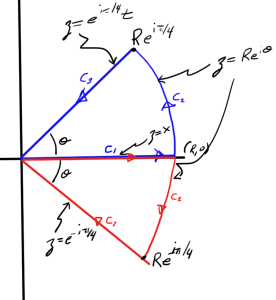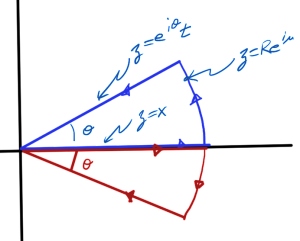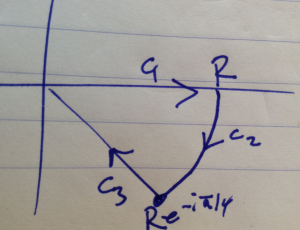
[Click here for a PDF of this post with nicer formatting]
Question:
Given a gauge transformation of the free particle Hamiltonian to
\begin{equation}\label{eqn:gaugeTx:20}
H = \inv{2 m} \BPi \cdot \BPi + e \phi,
\end{equation}
where
\begin{equation}\label{eqn:gaugeTx:40}
\BPi = \Bp – \frac{e}{c} \BA,
\end{equation}
calculate \( m d\Bx/dt \), \( \antisymmetric{\Pi_i}{\Pi_j} \), and \( m d^2\Bx/dt^2 \), where \( \Bx \) is the Heisenberg picture position operator, and the fields are functions only of position \( \phi = \phi(\Bx), \BA = \BA(\Bx) \).
Answer
The final results for these calculations are found in [1], but seem worth deriving to exercise our commutator muscles.
Heisenberg picture velocity operator
The first order of business is the Heisenberg picture velocity operator, but first note
\begin{equation}\label{eqn:gaugeTx:60}
\begin{aligned}
\BPi \cdot \BPi
&= \lr{ \Bp – \frac{e}{c} \BA} \cdot \lr{ \Bp – \frac{e}{c} \BA} \\
&= \Bp^2 – \frac{e}{c} \lr{ \BA \cdot \Bp + \Bp \cdot \BA } + \frac{e^2}{c^2} \BA^2.
\end{aligned}
\end{equation}
The time evolution of the Heisenberg picture position operator is therefore
\begin{equation}\label{eqn:gaugeTx:80}
\begin{aligned}
\ddt{\Bx}
&= \inv{i\Hbar} \antisymmetric{\Bx}{H} \\
&= \inv{i\Hbar 2 m} \antisymmetric{\Bx}{\BPi^2} \\
&= \inv{i\Hbar 2 m} \antisymmetric{\Bx}{\Bp^2 – \frac{e}{c} \lr{ \BA \cdot \Bp
+ \Bp \cdot \BA } + \frac{e^2}{c^2} \BA^2 } \\
&= \inv{i\Hbar 2 m}
\lr{
\antisymmetric{\Bx}{\Bp^2}
– \frac{e}{c} \antisymmetric{\Bx}{ \BA \cdot \Bp + \Bp \cdot \BA }
}
.
\end{aligned}
\end{equation}
For the \( \Bp^2 \) commutator we have
\begin{equation}\label{eqn:gaugeTx:100}
\antisymmetric{x_r}{\Bp^2}
=
i \Hbar \PD{p_r}{\Bp^2}
=
2 i \Hbar p_r,
\end{equation}
or
\begin{equation}\label{eqn:gaugeTx:120}
\antisymmetric{\Bx}{\Bp^2}
=
2 i \Hbar \Bp.
\end{equation}
Computing the remaining commutator, we’ve got
\begin{equation}\label{eqn:gaugeTx:140}
\begin{aligned}
\antisymmetric{x_r}{\Bp \cdot \BA + \BA \cdot \Bp}
&= x_r p_s A_s – p_s A_s x_r \\
&\quad+ x_r A_s p_s – A_s p_s x_r \\
&= \lr{ \antisymmetric{x_r}{p_s} + p_s x_r } A_s – p_s A_s x_r \\
&\quad+ x_r A_s p_s – A_s \lr{ \antisymmetric{p_s}{x_r} + x_r p_s } \\
&= \antisymmetric{x_r}{p_s} A_s + {p_s A_s x_r – p_s A_s x_r} \\
&\quad+ {x_r A_s p_s – x_r A_s p_s} + A_s \antisymmetric{x_r}{p_s} \\
&= 2 i \Hbar \delta_{r s} A_s \\
&= 2 i \Hbar A_r,
\end{aligned}
\end{equation}
so
\begin{equation}\label{eqn:gaugeTx:160}
\antisymmetric{\Bx}{\Bp \cdot \BA + \BA \cdot \Bp} = 2 i \Hbar \BA.
\end{equation}
Assembling these results gives
\begin{equation}\label{eqn:gaugeTx:180}
\boxed{
\ddt{\Bx} = \inv{m} \lr{ \Bp – \frac{e}{c} \BA } = \inv{m} \BPi,
}
\end{equation}
as asserted in the text.
Kinetic Momentum commutators
\begin{equation}\label{eqn:gaugeTx:200}
\begin{aligned}
\antisymmetric{\Pi_r}{\Pi_s}
&=
\antisymmetric{p_r – e A_r/c}{p_s – e A_s/c} \\
&=
{\antisymmetric{p_r}{p_s}}
– \frac{e}{c} \lr{ \antisymmetric{p_r}{A_s} + \antisymmetric{A_r}{p_s}}
+ \frac{e^2}{c^2} {\antisymmetric{A_r}{A_s}} \\
&=
– \frac{e}{c} \lr{ (-i\Hbar) \PD{x_r}{A_s} + (i\Hbar) \PD{x_s}{A_r} } \\
&=
– \frac{i e \Hbar}{c} \lr{ -\PD{x_r}{A_s} + \PD{x_s}{A_r} } \\
&=
– \frac{i e \Hbar}{c} \epsilon_{t s r} B_t,
\end{aligned}
\end{equation}
or
\begin{equation}\label{eqn:gaugeTx:220}
\boxed{
\antisymmetric{\Pi_r}{\Pi_s}
=
\frac{i e \Hbar}{c} \epsilon_{r s t} B_t.
}
\end{equation}
Quantum Lorentz force
For the force equation we have
\begin{equation}\label{eqn:gaugeTx:240}
\begin{aligned}
m \frac{d^2 \Bx}{dt^2}
&= \ddt{\BPi} \\
&= \inv{i \Hbar} \antisymmetric{\BPi}{H} \\
&= \inv{i \Hbar 2 m } \antisymmetric{\BPi}{\BPi^2}
+ \inv{i \Hbar } \antisymmetric{\BPi}{e \phi}.
\end{aligned}
\end{equation}
For the \( \phi \) commutator consider one component
\begin{equation}\label{eqn:gaugeTx:260}
\begin{aligned}
\antisymmetric{\Pi_r}{e \phi}
&=
e \antisymmetric{p_r – \frac{e}{c} A_r}{\phi} \\
&=
e \antisymmetric{p_r}{\phi} \\
&=
e (-i\Hbar) \PD{x_r}{\phi},
\end{aligned}
\end{equation}
or
\begin{equation}\label{eqn:gaugeTx:280}
\inv{i \Hbar} \antisymmetric{\BPi}{e \phi}
=
– e \spacegrad \phi
=
e \BE.
\end{equation}
For the \( \BPi^2 \) commutator I initially did this the hard way (it took four notebook pages, plus two for a false start.) Realizing that I didn’t use \ref{eqn:gaugeTx:220} for that expansion was the clue to doing this more expediently.
Considering a single component
\begin{equation}\label{eqn:gaugeTx:300}
\begin{aligned}
\antisymmetric{\Pi_r}{\BPi^2}
&=
\antisymmetric{\Pi_r}{\Pi_s \Pi_s} \\
&=
\Pi_r \Pi_s \Pi_s – \Pi_s \Pi_s \Pi_r \\
&=
\lr{ \antisymmetric{\Pi_r}{\Pi_s} + {\Pi_s \Pi_r} }
\Pi_s
– \Pi_s
\lr{ \antisymmetric{\Pi_s}{\Pi_r} + {\Pi_r \Pi_s} } \\
&= i \Hbar \frac{e}{c} \epsilon_{r s t}
\lr{ B_t \Pi_s + \Pi_s B_t },
\end{aligned}
\end{equation}
or
\begin{equation}\label{eqn:gaugeTx:320}
\begin{aligned}
\inv{ i \Hbar 2 m} \antisymmetric{\BPi}{\BPi^2}
&= \frac{e}{2 m c } \epsilon_{r s t} \Be_r
\lr{ B_t \Pi_s + \Pi_s B_t } \\
&= \frac{e}{ 2 m c }
\lr{
\BPi \cross \BB
– \BB \cross \BPi
}.
\end{aligned}
\end{equation}
Putting all the pieces together we’ve got the quantum equivalent of the Lorentz force equation
\begin{equation}\label{eqn:gaugeTx:340}
\boxed{
m \frac{d^2 \Bx}{dt^2} = e \BE + \frac{e}{2 c} \lr{
\frac{d\Bx}{dt} \cross \BB
– \BB \cross \frac{d\Bx}{dt}
}.
}
\end{equation}
While this looks equivalent to the classical result, all the vectors here are Heisenberg picture operators dependent on position.
References
[1] Jun John Sakurai and Jim J Napolitano. Modern quantum mechanics. Pearson Higher Ed, 2014.


